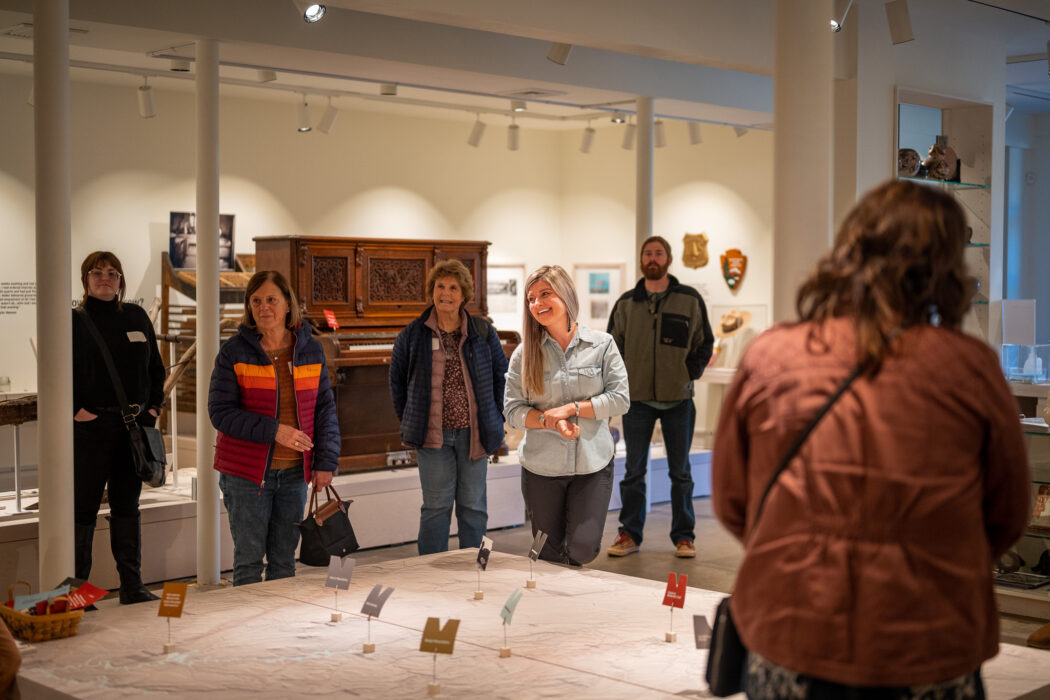Storytelling, history at Moab Museum
Tucked close to the red rocks of eastern Utah near the banks of the Colorado River lies the Moab Museum, only three miles down the road from the Utah State University Moab campus. Since its establishment in 1958, the museum has prioritized uncovering widely unknown or unrecognized parts of Moab’s history through educating and storytelling.
Forrest Rodgers, the executive director of the museum, first began working there in 2018.
“Some people say that museums should be the soul of a community,” Rodgers said. “They should be equipped and prepared to tell the stories of the community’s birth, its growth and development and the important people, places and events that shaped the community.”
The museum was founded at the height of the uranium boom, when Moab was the uranium capital of America. Throughout the ‘60s and ‘70s, the museum began to expand its collections and space. Though still limited in scale at the time, the museum showcased small exhibits that shared stories of the Moab pioneers.
“In the 1980s, the need for a larger building and greater financial stability led to some very generous private donations to construct a building and an annex, which basically created the museum footprint that we have today,” Rodgers said.
During this time, the museum launched a quarterly magazine called the Canyon Legacy. Each magazine issue focused on a theme that reflected an important aspect of Moab culture and history, such as the uranium boom and the ghost towns of southeastern Utah.
“In 2014, the museum board and directors started developing some very big, very ambitious plans for raising money to build a new building,” Rodgers said. “Their goal was somewhere between 35 and 50 million dollars.”
Though the campaign was ambitious for a small town of about 5,500 people, they wanted to restore their community with artifacts that had been collected in the southeast corner of Utah — artifacts which had since been transported to and stored at other, larger museums.
“The tagline was, ‘Bring our history home,’” Rodgers said.
When Rodgers was first hired as a consultant for the museum to aid in the expansion, he asked one simple question: “What does your community want?”
“I came to Moab under contract to interview 35 folks from the community to see what their attitudes and perceptions were about the museum,” Rodgers said.
According to Rodgers, the staff used those interviews to create an educational environment that reflected what the community truly wanted out of a museum.
“In the museum language, we would say that it was an attraction rather than a museum,” Rodgers said. “It was a place for people to go and see things, but not a place for storytelling, not a place to care for the collection, etc.”
When the former director of the museum left, Rodgers was asked to step into the role as museum executive director.
“We shifted the focus from objects to stories,” Rodgers said. “We have far more stories — as we share the stories of the Colorado plateau — than we have objects to tell them.”
The museum has optimized their usage of the limited space by incorporating touchscreens into their storytelling. This interactive element has kept older stories of the community alive as new exhibits and artifacts come through the museum.
One of the temporary exhibitions the museum will be showcasing until June of 2024 is called “A Moab Prison Camp: Japanese American Incarceration in Grand County.” It tells the story of a widely unknown period of Moab’s history during World War II.
“The euphemism that was used was ‘internment camp,’ and that was the language for most of the years since the end of World War II,” Rodgers said. “Until within the last five or ten years, people started calling them for what they were.”
According to the article “Moab’s Concentration Camp” by The Canyon Country Zephyr, 16 incarcerated Japanese Americans were relocated to an old Moab Civilian Conservation Corps camp turned temporary prison camp. The number of incarcerated individuals soon rose to around 54, as so-called “troublemakers” from other camps continued to be sent to the prison camp in Dalton Wells, Moab.
“Our exhibit attempts to share the story of the people who experienced this time of being uprooted from a place they called home and being transported to very unfamiliar places with very unfamiliar conditions,” Rodgers said.
According to Rodgers, this exhibit features images, letters and personal profiles of people who were incarcerated in the Moab prison camp at the time.
Mary Langworthy, the public programs coordinator of the museum, was the lead curator for this exhibit.
“The impetus for creating the exhibit was that there’s been a lot of renewed interest and curiosity, particularly as they’re making a new state park,” Langworthy said.
The new Utahraptor State Park, named after the discovery of prehistoric remains found in the area, is currently being constructed at the site of the prison camp in Dalton Wells.
“This is our effort to help our community learn a bit more about this piece of the past that hadn’t really been talked about in a big way,” Langworthy said.
According to Langworthy, many visitors express their gratitude towards this exhibit for addressing and remembering this difficult part of Moab history.
“Storytelling is kind of the basic human language,” Langworthy said. “The power of a story is really tremendous. It helps us understand history, not just as the dusty realm of the past, but as something that has continued relevance for us today.”

